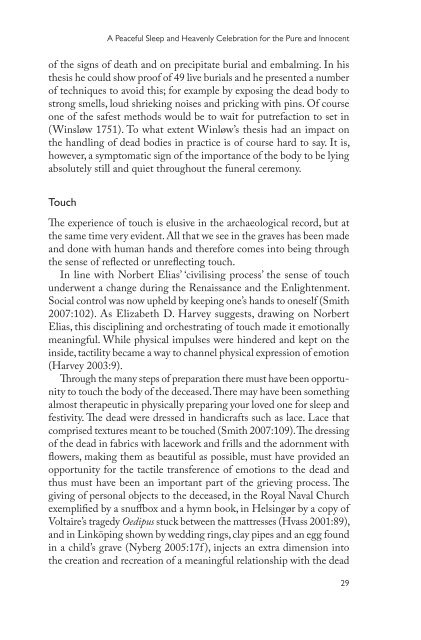Making Sense of Things
Making Sense of Things
Making Sense of Things
Create successful ePaper yourself
Turn your PDF publications into a flip-book with our unique Google optimized e-Paper software.
A Peaceful Sleep and Heavenly Celebration for the Pure and Innocent<br />
<strong>of</strong> the signs <strong>of</strong> death and on precipitate burial and embalming. In his<br />
thesis he could show pro<strong>of</strong> <strong>of</strong> 49 live burials and he presented a number<br />
<strong>of</strong> techniques to avoid this; for example by exposing the dead body to<br />
strong smells, loud shrieking noises and pricking with pins. Of course<br />
one <strong>of</strong> the safest methods would be to wait for putrefaction to set in<br />
(Winsløw 1751). To what extent Winløw’s thesis had an impact on<br />
the handling <strong>of</strong> dead bodies in practice is <strong>of</strong> course hard to say. It is,<br />
however, a symptomatic sign <strong>of</strong> the importance <strong>of</strong> the body to be lying<br />
absolutely still and quiet throughout the funeral ceremony.<br />
Touch<br />
The experience <strong>of</strong> touch is elusive in the archaeological record, but at<br />
the same time very evident. All that we see in the graves has been made<br />
and done with human hands and therefore comes into being through<br />
the sense <strong>of</strong> reflected or unreflecting touch.<br />
In line with Norbert Elias’ ‘civilising process’ the sense <strong>of</strong> touch<br />
underwent a change during the Renaissance and the Enlightenment.<br />
Social control was now upheld by keeping one’s hands to oneself (Smith<br />
2007:102). As Elizabeth D. Harvey suggests, drawing on Norbert<br />
Elias, this disciplining and orchestrating <strong>of</strong> touch made it emotionally<br />
meaningful. While physical impulses were hindered and kept on the<br />
inside, tactility became a way to channel physical expression <strong>of</strong> emotion<br />
(Harvey 2003:9).<br />
Through the many steps <strong>of</strong> preparation there must have been opportunity<br />
to touch the body <strong>of</strong> the deceased. There may have been something<br />
almost therapeutic in physically preparing your loved one for sleep and<br />
festivity. The dead were dressed in handicrafts such as lace. Lace that<br />
comprised textures meant to be touched (Smith 2007:109). The dressing<br />
<strong>of</strong> the dead in fabrics with lacework and frills and the adornment with<br />
flowers, making them as beautiful as possible, must have provided an<br />
opportunity for the tactile transference <strong>of</strong> emotions to the dead and<br />
thus must have been an important part <strong>of</strong> the grieving process. The<br />
giving <strong>of</strong> personal objects to the deceased, in the Royal Naval Church<br />
exemplified by a snuffbox and a hymn book, in Helsingør by a copy <strong>of</strong><br />
Voltaire’s tragedy Oedipus stuck between the mattresses (Hvass 2001:89),<br />
and in Linköping shown by wedding rings, clay pipes and an egg found<br />
in a child’s grave (Nyberg 2005:17f ), injects an extra dimension into<br />
the creation and recreation <strong>of</strong> a meaningful relationship with the dead<br />
29

















